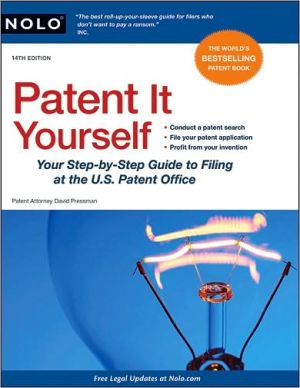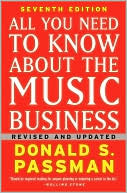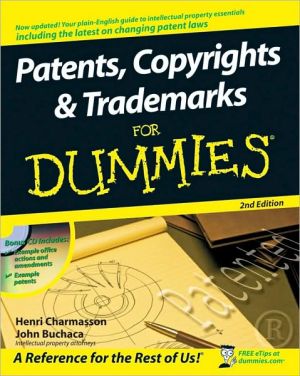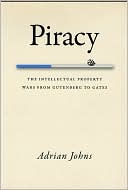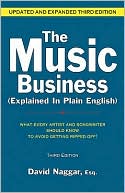Patent It Yourself
Celebrating 20 years of success!\ Patent It Yourself is the world's bestselling patent book, recommended by patent attorneys, inventors, librarians and journalists.\ Patent attorney and former patent examiner David Pressman takes you -- step-by-step and in plain English -- through the entire patent process, from conducting a patent search to filing a successful application.\ Patent It Yourself also covers:\ \ documenting the invention process\ successful marketing strategies\ foreign patent...
Search in google:
Patent your creation with the world's bestselling guide to patents! Have a world-class idea? Ready to protect your invention from copycats? Then turn to the best resource available-- Patent It Yourself.Attorney David Pressman takes you through the entire patent process, providing scrupulously updated information and clear instructions to help you.Thoroughly updated to reflect the latest changes in intellectual property law, the 14th edition also provides the latest U.S. Patent and Trademark Office rules and forms. It includes up-to-date details on how to file a patent electronically with the USPTO, the latest rules for application and prosecution, and other changes to technical filing rules. San Francisco Chronicle Every step of the patent process is presented in order in this gem of a book, complete with official forms....
Introduction\ \ Inventor's Commandment 2\ To invent successfully, be aware of problems you encounter and seek solutions. Also, take the time to study and investigate the practicality of new phenomena that occur by accident or fl ash of insight. Persevere with any development you believe has commercial potential.\ \ Before we get to patents, the primary subject of this book, I provide this chapter to discuss inventions and inventing. why do this? To begin, you may be a first-time inventor and thus have no experience in the real world of protecting and patenting inventions. I believe that you'll be a better inventor if you understand and become familiar with some successful inventors and the invention process. Also, I believe that too many first-timers get discouraged before they try enough. To inspire you to hang in there, I include here some past success stories. Hopefully, when you see that many other small, independent inventors have found their pot of gold, you'll be stimulated to press on.\ \ Inventing can not only be profitable, but it provides things that enhance our lives, making them more interesting, pleasurable, exciting, rewarding, and educational. as the noted Swiss psychologist, piaget, once said, "we learn most when we have to invent." Remember that everything of significance, even the chair you're probably seated in now, started with an idea in someone's brain. if you come up with something, don't dismiss it; it could turn out to be something great!\ \ Common Misconception: The day of the small inventor is over; an independent inventor no longer has any chance to make a killing with his or her invention.\ \ Fact: As you'll see by theexamples given later in this chapter, many small, independent inventors have done extremely well with their inventions. Billions of dollars in royalties and other compensation are paid each year to independent inventors for their creations. In fact 73% of all inventions that have started new industries have come from individual inventors. So, don't be a victim of the "no-use-going- on-with-it-because-surely-someone-has- invented-it- already" syndrome. While i recommend that you don't rush blindly ahead to patent your work without making a sensible investigation of prior inventions and your creation's commercial potential (in the ways i discuss later), I urge you not to quit without giving your invention a fair chance.\ \ Another reason for this chapter is that many inventors come up with valuable inventions, but they haven't developed them sufficiently so that they can be readily sold. if their creations could be improved with further work, they'd have a far greater chance of success. So here I'll also give some hints about such things as improving your inventions, solving problems about workability, and drawbacks.\ \ If you've already made an invention, or are even in the business of inventing, I believe the techniques in this chapter that increase your creativity and provide additional stimulation will help you to make more and better inventions. On the other hand, I also recognize that the information in this chapter may not be particularly helpful to the experienced inventor or the corporate inventor-after all, you're already firmly in the inventing business. If you would rather skip this information for now, go to chapter 3, where my discussion of record keeping should prove of value to even the most seasoned of inventors.\ What I Mean by "Invention"\ \ For the purpose of this book, an invention is any thing, process, or idea that isn't generally and currently known; which, without too much skill or ingenuity, can exist in or be reduced to tangible form or used in a tangible thing; which has some use or value to society; and which you or someone else has thought up or discovered.\ \ Note that under this definition, an invention can be a process or even an idea, so long as it can be made tangible in some way, "without too much skill or ingenuity." on the other hand, the definition eliminates fantasies and wishes, such as time-travel or perpetual motion machines, since these obviously (at least to me) can't be made tangible.\ \ An invention must have some use or value to society; otherwise what good is it, and how will you sell it? it must be generally unknown anywhere in the world (at the time you invent it), and it must have been thought up or discovered by you or someone else-otherwise it doesn't really have inventive value.\ \ While you may think that an invention must be a major development to be successful, the truth is that most successful inventions are evolutionary rather than revolutionary. For example, the basic concept of the transistor was invented in the 1930s, but was not feasible enough to be successful until Drs. Brittain, Bardeen, and Shockley made some evolutionary but successful improvements in the late 1940s.\ \ Why do I bother to define the term invention in such detail? So you'll begin to understand it and have a better feel for it, as well as to define the limits of its usage in this book. As you'll see, my primary concern is with inventions that qualify for a patent (that is, patentable inventions). However, nonpatentable inventions can also be valuable as long as society finds them at least somewhat special and useful.\ Inventing by Problem Recognition and Solution\ \ Now that you know what an invention is, how do you make one? Most inventions are conceived by the following two-step procedure: (1) recognizing a problem, and (2) fashioning a solution.\ \ Although it may seem like duck soup, recognizing a problem often amounts to about 90% of the act of conceiving the invention. "To be an inventor is to perceive need." In these situations, once the problem is recognized, conceiving the solution is easy. Consider some of the Salton products-the home peanut butter maker, for instance, or the plug-in ice cream maker for use in the freezer. In both cases, once the problem was defined (the need for an easy homemade version of a product normally purchased at the store) implementing the solution merely involved electrification and/or size reduction of an existing appliance. Once the problem was defined, any competent appliance designer could accomplish its solution. True, during the implementation of the idea, that is, the design of the actual hardware, designers and engineers often contribute the very aspects of the invention that make it ingenious and patentable. Still, the main ingredient leading to a successful outcome for most inventions consists of recognizing and defining the problem that needs to be solved. Although Edison seemed to contradict this when he said that inventing is 10% inspiration and 90% perspiration, he was referring to the whole experience of inventing, including conception, making a practicable model, and licensing or selling the invention. Here, I'm referring just to the conception part of inventing-what Edison called "inspiration."\ \ Of course, in some contexts, the recognition of a problem plays no part in the invention. Most improvement inventions fall into this category, such as, for example, the improvement of the mechanism of a ballpoint pen to make it cheaper, more reliable, stronger, etc. But in general, you will find it most effective to go about inventing via the two-step process of identifying a problem and solving it. Or, as famed inventor Jacob Rabinow said, "You invent because something bothers you."\ \ Let's look at some simple inventions that were made using this two-step process and which have been commercially implemented. I delineate the problem P and solution S in each instance. Where I know an Independent Inventor was responsible, I add an "II."\ \ 1. Grasscrete. P Wide expanses of concrete or asphalt in a parking lot or driveway are ugly. S Make many cross-shaped holes in the paving and plant grass in the earth below so that the grass grows to the surface and makes the lot or driveway appear mostly green; grass is protected from the car's tires because of its subsurface position.\ 2. Intermittent Windshield Wipers. P In drizzles, the slowest speed of windshield wipers was unnecessarily fast, and merely slowing the wipers was unsatisfactory, since a slow sweep was annoying. S Provide a "drizzle" setting where the windshield wipers made normally fast sweeps but paused after each sweep. (Robert Kearns,II. Mr. Kearns's brilliantly ingenious yet utterly ingenuous solution earned him and his estate over $50 million in royalties.)\ 3. Buried Plastic Cable-Locator Strip. P Construction excavators often damage buried cables (or pipes) because surface warning signs often are removed or can't be placed over the entire buried cable. S Bury a brightly colored plastic strip parallel to and above the cable; it serves as a warning to excavators that a cable is buried below the spot where they're digging. (This is a "new-use" invention since the plastic strip per se was obviously already in existence.)\ 4. Magnetic Safety Lock for Police Pistols. P Police pistols are often fired by unauthorized persons. S A special safety lock inside the pistol releases only when the pistol is held by someone wearing a finger ring containing a high-coercive-force samariumcobalt magnet.\ 5. Wiz-z-er™ Gyroscopic Top. P Gyroscopes are difficult to get running: they require the user to wind a string around a shaft surrounded by gimbals and then pull it steadily but forcefully to set the rotor in motion. S Provide an enclosed gyro in the shape of a top with an extending friction tip that can be easily spun at high speed by moving it across any surface. (Paul Brown,II. Mr. Brown came up with this great invention because, while at a party, he had repeated difficulty operating a friend's son's gyro. His first royalty check from Mattel was five times his annual salary!)\ 6. Dolby®Audio Tape Hiss Elimination. P Audio tapes played at low volume levels usually have an audible hiss. S Frequency-selective compounding of the audio during recording and expanding of the audio during playback to eliminate hiss. (Ray Dolby, one of the most successful IIs of modern times.)\ 7. Xerography. P Copying documents required messy, slow, complicated photographic apparatus. S Xerography-the charging of a photosensitive surface in a pattern employing light reflected from the document to be copied and then using this charged surface to pick up and deposit black powder onto a blank sheet. (Chester Carlson,II. When Mr. Carlson, a patent attorney, brought his invention to Kodak, they said it could never be commercially implemented and rejected it. Undaunted, he brought it to The Haloid Co., which accepted it and changed its name to Xerox Corporation; the rest is history.)\ 8. 8. Flip-Top Can. P Cans of beverage were difficult to open, requiring a church key or can opener. S Provide the familiar flip-top can. (Ermal Frase,II.)\ 9. FM, CW, and AGC. P Information wasn't conveyable by radio due to noisy, limited frequency response and fade-out of AM reception. S Provide CW , FM, and AGC circuitry, familiar to all electronic engineers. (Edwin Howard Armstrong,II, the genius of high fidelity.)\ 10. Thermostatic Shower Head. P Shower takers sometimes get burned because they inadvertently turn on the hot water while standing under the shower. S Provide a thermostatic cut-off valve in the supply pipe. (Alfred M. Moen,II.)\ 11. VCR Plus. P Most people are too lazy or too put off by technical matters to learn how to enter a date, time, and channel into their VCR . S With VCR Plus, each program is assigned a special code number in the newspaper and the VCR owner need merely enter the number and transmit it to the VCR.\ 12. Organic Production of Acetone. P During WWI , the U.K. desperately needed acetone to make explosives, since its normal source was cut off. S Use an anaerobic bacterium to produce acetone from locally available corn mash. (Dr. Chaim Weizmann. This invention helped save one nation and start a new one: It was instrumental in helping the U.K. and the Allies survive WWI and defeat the Germans. The U.K. rewarded Weizmann with the Balfour Declaration, which helped lead to the eventual formation of the State of Israel.)\ 13. Grocery Shopping Cart. P Shoppers in grocery stores used their own small, hand-carried wicker baskets and bought only the small amounts that they could carry in the baskets, thereby necessitating several trips to the grocery and causing sales to be relatively low per customer visit. S Provide a "grocery cart," that is, a large wire basket in a frame on wheels so that it can be rolled about and carry a large amount of groceries. (Sylvan Goldman,II. When Mr. Goldman first introduced his carts (about 1925), shoppers wouldn't use them and stores wouldn't buy them despite his extensive efforts. He eventually found a way to get his carts accepted: he hired crews of "shoppers" to wheel the carts about and fill them in his store, and also hired a woman to offer the carts to entering shoppers. Goldman then made millions from patents on his cart and its improvements (nesting carts and airport carts). This illustrates the crucial value of perseverance and marketing genius.)\ 14. Belt Loops. P Until 1922, men's pants (then called pantaloons) were held up by either unsightly suspenders or an awkward rope tied around the top of the pants. S Provide "loops" at the top of the pants so that a "belt" could be inserted through the loops. (Unknown inventor).\ \ A list of other famous inventors and their inventions can be found at www.zoomschool.com/inventors.\ \ The inventors of these inventions necessarily went through the problem-solution process (though not necessarily in that order) to make their invention. Even if an inventor believes the invention came spontaneously, you'll usually find that problem-solution steps were somehow involved, even if they appear to coalesce.\ \ So, if you either don't have an invention or want to make some new ones, you should begin by ferreting out problem or "need" areas. This can often be done by paying close attention to your daily activities. How do you or others perform tasks? What problems do you encounter and how do you solve them? What needs do you perceive, even if they're as simple as wanting a full month's calendar on your calendar watch? Ask yourself if something can't be done more easily, cheaply, simply, or reliably, if it can't be made lighter, quicker, stronger, etc. Write the problems down and keep a list. Make sure you take the time to cogitate on the problems or needs you've discovered.\ \ Sometimes the solution to the problem you identify will be a simple expedient, such as electrification or reduction in size. Generally, however, it will be more involved, as in some of the examples listed above. But you don't have to be a genius to come up with a solution. Draw on solutions from analogous or even nonanalogous fields. Experiment, meditate, look around. When a possible solution strikes you, write it down, even if it's in the middle of the night. History records a great number of important scientific and conceptual breakthroughs occurring during sleep or borderline-sleep states.\ \ Also, remember that sometimes the "problem" may be the ordinary way something has been done for years, and which no one has ever recognized as a problem. Consider shower heads. Although essentially the same device operated satisfactorily for about 50 years, the inventor of water-massaging shower heads recognized the deficiency of an ordinary constant spray that didn't create any massage effect. He thus developed the water-massaging head that causes the water to come out in spurts from various head orifices, thereby creating the massaging effect.
I. Introduction 1. Introduction to Patents and Other Intellectual Property 2. The Science and Magic of Inventing 3. Documentation, the DDP, and the PPA 4. Will Your Invention Sell? 5. What Is Patentable? 6. Search and You May Find 7. What Should You Do Next? 8. How to Draft the Specification and Initial Drawings 9. Now for the Legalese -- The Claims 10. Finaling and Mailing Your Application 11. How to Market Your Invention 12. Going Abroad 13. Getting the PTO to Deliver 14. Your Application Can Have Children 15. After Your Patent Issues: Use, Maintenance, and Infringement 16. Ownership, Assignment, and Licensing of Inventions Appendices Index
\ About.comIt is the most definitive, complete and current do-it-yourself patent book ever written and it is written in easy-to-understand laymen's terms.\ \ \ \ \ Science NewsEntertaining and simple prose makes even the most arcane patent office procedures and policies understandable.\ \ \ The Washington PostIf you want to cut through the patent red tape and possibly save thousands of dollars, Patent It Yourself... has all the forms and instructions needed to patent a product in the United States.\ \ \ \ \ Inc.The best roll-up-your-sleeves guide for filers who don't want to pay a ransom.\ \ \ \ \ Mary BellisIt is the most definitive, complete and current do-it-yourself patent book ever written and it is written in easy-to-understand laymen's terms. \ — Inventor's Guide at About.com\ \ \ \ \ Money Magazine... contains all necessary forms and instructions plus advice on marketing your invention.\ \ \ \ \ Money Magazine... contains all necessary forms and instructions plus advice on marketing your invention.\ \ \ \ \ San Francisco ChronicleEvery step of the patent process is presented in order in this gem of a book, complete with official forms....\ \ \ \ \ Library JournalThis is a revised and considerably enlarged edition of a book published in 1979 by McGraw-Hill ( LJ 7/79). It is more thorough and provides better coverage of peripheral topics (e.g, how to keep lab notebooks, marketing and licensing inventions) than Kenneth Norris's The Inventor's Guide to Low-Cost Patenting ( LJ 7/85). Norris, however, includes more extracts from relevant regulations and the Manual of Patent Examining Procedure. The heart of both books is the process of acquiring a patent: searching for "prior art,'' drafting claims and applications, making drawings and responding appropriately to "office actions'' of the Patent and Trademark Office. Pressman writes well and formats the material for easy reference. Recommended for public libraries. \ -- Jack Ray, Loyola/Notre Dame Library, Baltimore\ \ \ \ \ Library JournalThis is a revised and considerably enlarged edition of a book published in 1979 by McGraw-Hill ( LJ 7/79). It is more thorough and provides better coverage of peripheral topics (e.g, how to keep lab notebooks, marketing and licensing inventions) than Kenneth Norris's The Inventor's Guide to Low-Cost Patenting ( LJ 7/85). Norris, however, includes more extracts from relevant regulations and the Manual of Patent Examining Procedure. The heart of both books is the process of acquiring a patent: searching for "prior art,'' drafting claims and applications, making drawings and responding appropriately to "office actions'' of the Patent and Trademark Office. Pressman writes well and formats the material for easy reference. Recommended for public libraries. \ -- Jack Ray, Loyola/Notre Dame Library, Baltimore\ \ \ \ \ BooknewsFor anyone who's ever hoped their invention will be as ubiquitous as Velcro, this book offers clear, detailed, copious instruction on how to submit a patent. Pressman (a patent attorney) discusses patents, inventions, considerations of salability, other options besides patenting, and marketing. Everything needed to apply for a patent<-- >legal format, fees, illustrations, language, patent office rules<--> is described in detail, and all the necessary forms are included. The new edition discusses the controversial "business method" patent, expands on requirements and filing procedures, includes changes resulting from the American Inventors Protection Act of 1999, and lists useful websites. Annotation c. Book News, Inc., Portland, OR (booknews.com)\ \ \ \ \ Denver PostThe book presents complicated procedures in easily digested chunks, with anecdotes, forms and plenty of old-fashioned good advice.\ \ \ \ \ InventNet.comThe most complete and authoritative work on patents and inventions for the layperson.\ \ \ \ \ The Washington PostIf you want to cut through the patent red tape and possibly save thousands of dollars, Patent It Yourself thoroughly explains the patent process and copyright laws and has all the forms and instructions needed to patent a product in the United States.\ \ \ \ \ Dallas Morning NewsThis clearly written guide will help minimize legal fees by preparing you to do what you can for yourself...\ — Mike Maza\ \ \ \ \ Inc. MagazineThe best roll-up-your-sleeves guide for filers who don't want to pay a ransom.\ \ \ \ \ InventNetThe most complete and authoritative work on patents and inventions for laypersons...\ \ \ \ \ Money MagazineContains all necessary forms and instructions plus advice on marketing your invention.\ \ \ \ \ San Francisco ChronicleEvery step of the patent process is presented in order in this gem of a book, complete with official forms...\ \ \ \ \ San Francisco ExaminerPatent It Yourself is a top-notch reference for patent and trademark information.\ \ \ \ \ Self-Employed AmericaWill help you navigate the complexities of filing a patent.\ \ \ \ \ The Denver PostThe book presents complicated procedures in easily digested chunks, with anecdotes, forms and plenty of old-fashioned good advice.\ \ \ \ \ The Inventor's BookstoreEasy to understand and can save thousands of dollars by writing your own patent application, or by writing much of it...\ — Jack Lander\ \
